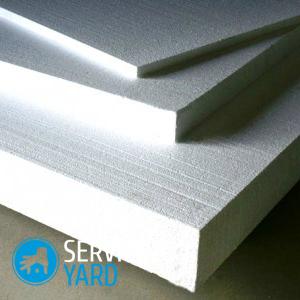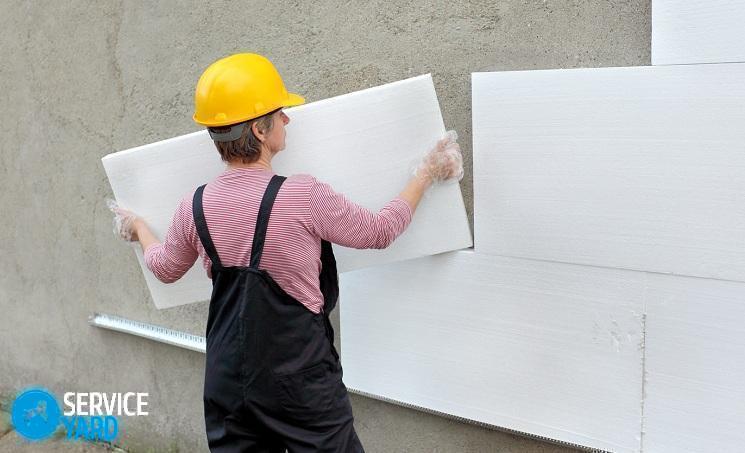How to glue foam?

Recently, the use of polystyrene during repair and construction has become very popular. This porous material is very convenient in that it is light in weight and a seemingly huge block can be easily lifted even by a child. When working with him, feasible help can be provided by children by submitting blocks. This material is not subject to decay, with proper use it can last for more than a dozen years, without losing its properties. Therefore, it is important to know how and with what to stick the foam. Let's take a closer look at what this polystyrene foam is, why it is so good, but at the same time we will find out on what glue it is better to glue it.
to contents ↑Advantages of Styrofoam
This material is very light due to the fact that it is 98% gas. It is able to withstand large temperature differences, precipitation and has several other advantages:
- It has a long service life.
- It can be given any shape, although for construction and repairs it is most often produced in the form of blocks or plates.
- Over time, the material does not shrink, does not change its size.
- It has high rigidity, does not bend and does not deform under loads.
- Easy to cut to size.
- Non toxic
- Resistant to moisture.
- Mold does not appear on it.
- It resists exposure to fire. Its spontaneous combustion temperature is 491 degrees.
- It has a low cost.
- Inert, does not interact with other substances.
But it can’t do without cons:
- This is a brittle material, which, moreover, does not allow air to pass through, therefore it is not recommended to completely paste over the living room.
- In addition, it decomposes from ultraviolet rays, so it also needs to be protected from the sun.
- Many solvents can harm it, so when painting and gluing it is necessary to carefully select the composition.
The use of foam:
- Most often, this material is used in construction and repair. It can be glued to brick, foam concrete, metal, plywood, wood and other surfaces. Therefore, it is used for insulation of houses, for preliminary finishing of ceilings, floors and walls, as well as for external insulation.
- In shipbuilding, it is used for the manufacture of life belts, boats, boats, etc.
- In medicine, it is used to make containers for transporting organs and drugs.
- In the manufacture of furniture, it is added to the composition of materials from which various products are subsequently made.
- Polyfoam is also used for the manufacture of packaging materials, it is part of various packaging, wrappers.
- It is also used in the manufacture of outdoor advertising. It is part of advertising banners and signs.
- It is also used in the manufacture of clothing. Products that include polystyrene are very warm.
Glue the foam correctly
Now that we know what the necessary and useful piece of polystyrene foam is, it's time to talk about how to glue it properly. It is important to choose the correct composition of the glue. Do not take glue if its composition includes components such as:
- esters (methyl acetate, butyl acetate);
- alcohols;
- natural gas derivatives (propane, hexane and others);
- amines (aniline, etc.);
- hydrocarbon processing products (gasoline, kerosene, white spirit);
- ketones (acetone, etc.);
- compounds containing chlorine (dichloroethane, chloroform);
- nitrogen compounds (nitrobenzene, nitromethane).
Why? We explain: with time or right away - if you are lucky, such glue will spoil the structure of the material and it will become unusable. How to stick polystyrene?
For this case, there are several options that will suit both you and your polystyrene. Let's consider them in more detail.
Dry formulations
With the help of a dry adhesive composition, foam can be glued qualitatively. Moreover, this option will cost you inexpensively. True, you will have to spend time diluting the glue, and it will dry for a long time and tediously - about three days.
Important! Such glue will not help you stick the foam to a metal surface or to concrete.
If you settled on this option, then when buying glue, consider the following points:
- Try to buy from trusted manufacturers. In addition, it is advisable to buy sealed bags that were stored indoors, otherwise - the composition could simply become wet.
- Check the expiration date of the goods.
- Content by touch should not be like stone.
The finished mixture is applied either to the surface or to the plate itself. Glue the boards from bottom to top.
PVA
If the question arises, how to glue the foam to metal with glue, then our old proven PVA glue will help us, which will perfectly cope with the task:
- Glue the burlap with glue, fix it on a metal surface.
- Lubricate the stove with plenty of glue.
- Place the plate on the surface and hold it for a while until adhesion occurs.
"Liquid Nails"
Many formulations involve holding the slab for some time on the surface. How to glue polystyrene foam so as not to waste extra time on all sorts of unnecessary manipulations? Here you can use the “Liquid Nails” universal glue, which quickly and effortlessly glue polystyrene onto any surface. It's just that this pleasure is a little expensive, but then it's up to you.
Polyurethane foam
In this way, polystyrene can be glued to concrete, brick or stone. It is simple and reliable, but there are some disadvantages:
- First of all, it will take you too much foam.
- It will dry for a long time.
- Over time, its structure may collapse, as a result - the structure will be unreliable.
Polyurethane foam adhesive
Since polystyrene became so popular, manufacturers couldn’t stay away, so a specially developed adhesive was released to fix polystyrene foam. It will stick your sheet to any surface, while ensuring good adhesion. It is convenient in work, dries quickly.
Spray glue
Such glue is available in the form of aerosol cans, so working with it is simple and convenient.
to contents ↑How to glue foam?
Now that we know what polystyrene can be glued on, it remains to clarify one point - how to do it correctly.
Important! To improve adhesion, the surface of the plate can be treated with a needle roller before gluing.
Before you start sticking the material, you need to prepare the surface. This is done in two stages:
- Clean the surface of dirt and dust.
- If there are defects on the surface, such as potholes, they must be leveled with tools. Otherwise, grip will be weak.
So, you picked up the glue, cleaned the surface. How to glue foam?
- Apply glue to the foam sheet or block. It is usually applied in stripes or dots. The glue should be evenly distributed over the entire surface.
- Press the sheets firmly to the surface. It is advisable to use the load, if possible, or just squeeze with your hands and hold for some time.
to contents ↑Important! Methods of applying glue depends on the shape of the sheet itself, as well as on its size. When gluing plates to the ceiling, you can use a rolling pin for dough. If excess glue comes out, immediately remove it with a spatula.
Stock footage
In this article, we examined in detail all the options for gluing polystyrene foam and figured out the gluing technology, which turned out to be very simple.We hope that our review has helped you quickly cope with the work and you have achieved the desired result.
- How to choose a vacuum cleaner taking into account the characteristics of the house and coatings?
- What to look for when choosing a water delivery
- How to quickly create comfort at home - tips for housewives
- How to choose the perfect TV - useful tips
- What to look for when choosing blinds
- What should be running shoes?
- What useful things can you buy in a hardware store
- Iphone 11 pro max review
- Than iPhone is better than Android smartphones




